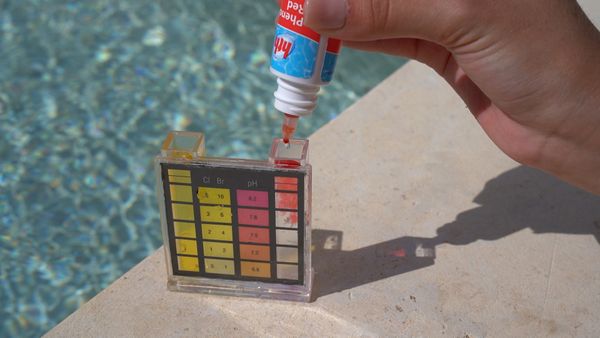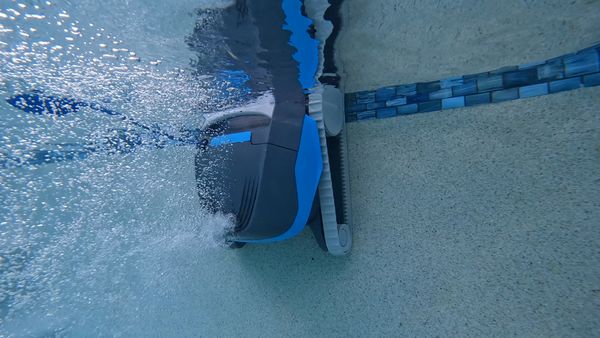Pool Maintenance Essentials
Keeping your pool clean and healthy made simple
January 16th, 2025
January 16th, 2025

The Big 3: Chemistry, Cleaning, and Circulation
Let’s dive into the essential pieces of pool maintenance: water chemistry, maintenance, and water circulation. This guide will provide all you need to do to keep your pool clean and healthy! So let’s dive in!
Water chemistry is easy to overlook but is vital to keeping your pool healthy and easy to maintain. Most experts agree that testing your pool water once a week is all that is needed to stay on top of your pool’s chemistry, but you may need to test more often if there is a big storm, party, or something is spilled in the pool. Whenever you check your pool chemistry there are two main things you will want to keep your eyes on: pH and alkalinity.
You want to keep your pool's pH betyween 6.9-7.2. pH is the measure of how base or acidic your water is that is measured on a scale from 0-14. You want your water to be close to 7 to ensure the water does not irritate your skin or eyes or harm your pool’s lining. We recommend a range between 6.9 and 7.2 which is a tight range though, and that is why you will want to pay attention to alkalinity.
Learn how to raise your pool's pH levels →
Learn how to lower your pool's pH levels →
Alkalinity helps to stabilize your pH levels, and if you want to make sure your pH levels don’t fluctuate wildly, you will want to keep your alkalinity levels between 100-150 ppm.
To keep your swimming pool at these levels, you may need to add either sodium bicarbonate or muriatic acid. If your pH levels are lower than 6.9-7.2, you will need to raise it with sodium bicarbonate, also known as baking soda. How much sodium bicarbonate or baking soda should you add? Or if your pH is higher than 6.9-7.2, it will need to be lowered with muriatic acid. How much muriatic acid should you add?
Well, it will depend on 2 things: pool volume and starting pH.
Here is a simple chart to use for sodium bicarbonate to raise pH:
| Pool Volume | |||||
|---|---|---|---|---|---|
| Increase By (Parts Per Million) | 5,000 Gallons (18,927 Liters) | 10,000 Gallons (37,854 Liters) | 15,000 Gallons (56,781 Liters) | 20,000 Gallons (75,708 Liters) | |
| 10 ppm | 0.75 lbs (340 g) | 1.5 lbs (680 g) | 2.25 lbs (1.02 kg) | 3.0 lbs (1.36 kg) | |
| 20 ppm | 1.5 lbs (680 g) | 3.0 lbs (1.36 kg) | 4.5 lbs (2.04 kg) | 6.0 lbs (2.72 kg) | |
| 30 ppm | 2.25 lbs (1.02 kg) | 4.5 lbs (2.04 kg) | 6.75 lbs (3.06 kg) | 9.0 lbs (4.08 kg) | |
| 40 ppm | 3.0 lbs (1.36 kg) | 6.0 lbs (2.72 kg) | 9.0 lbs (4.08 kg) | 12.0 lbs (5.44 kg) | |
| 50 ppm | 3.75 lbs (1.70 kg) | 7.5 lbs (3.40 kg) | 11.25 lbs (5.10 kg) | 15.0 lbs (6.80 kg) | |
| 60 ppm | 4.5 lbs (2.04 kg) | 9.0 lbs (4.08 kg) | 13.0 lbs (5.89 kg) | 18.0 lbs (8.16 kg) | |
| 70 ppm | 5.25 lbs (2.38 kg) | 10.5 lbs (4.76 kg) | 15.75 lbs (7.14 kg) | 21.0 lbs (9.52 kg) | |
| 80 ppm | 6.0 lbs (2.72 kg) | 12.0 lbs (5.44 kg) | 18.0 lbs (8.16 kg) | 24.0 lbs (10.88 kg) | |
| 90 ppm | 6.75 lbs (3.06 kg) | 13.5 lbs (6.12 kg) | 20.25 lbs (9.18 kg) | 27.0 lbs (12.24 kg) | |
| 100 ppm | 7.5 lbs (3.40 kg) | 15.0 lbs (6.80 kg) | 22.5 lbs (10.20 kg) | 30.0 lbs (13.60 kg) | |
Read more on raising your pool's pH here →
And here is a simple chart to use for muriatic acid to lower pH to the ideal pH of 6.9-7.2:
| Pool Volume | |||||
|---|---|---|---|---|---|
| Your Starting pH Levels | 1,000 Gallons (4,546 Liters) | 5,000 Gallons (18,927 Liters) | 10,000 Gallons (37,854 Liters) | 15,000 Gallons (56,781 Liters) | 20,000 Gallons (75,708 Liters) |
| 7.6 - 7.8 | 1.25 oz (35 ml) | 6 oz (170 ml) | 12 oz (340 ml) | 18 oz (510 ml) | 24 oz (680 ml) |
| 7.8 - 8.0 | 1.5 oz (43 ml) | 8 oz (227 ml) | 16 oz (454 ml) | 24 oz (680 ml) | 1 qt (907 ml) |
| 8.0 - 8.4 | 2.5 oz (71 ml) | 12 oz (340 ml) | 24 oz (680 ml) | 1.25 qts (1.18 L) | 1.5 qts (1.42 L) |
| Above 8.4 | 3.0 oz (85 ml) | 16 oz (454 ml) | 1 qt (907 ml) | 1.5 qts (1.42 L) | 2 qts (1.89 L) |
When adding chemicals to your pool, pour it in the deepest area of your pool, and make sure your pool pump is circulating the water. Also, be sure to wait at least a few hours, or 24 hours after adding a lot of chemicals if the water was heavily imbalanced.
To make maintaining your pool chemistry even easier, we recommend looking at the Spectralight Ultraviolet Light Disinfectant System. The Spectralight disinfects your water with UV rays, which can cut down on your chemical usage by up to 90%. With less chemicals going into your water, your water chemistry will be much easier to watch and maintain, not to mention your pool will be safer. If you want to learn more about the Spectralight, hop on over to our Pool Pad Essentials video that explains all it can do.
Once you have made a habit of checking and maintaining your pool’s chemistry, the next essential piece of pool maintenance is cleaning. We recommend vacuuming your pool weekly and scrubbing and skimming as often as possible. An easy solution to easy maintenance is a robotic pool cleaner.

A robotic pool cleaner can scrub, vacuum, and circulate your water for you, which means you can enjoy your pool rather than work on it. Hop on over to our top 5 best robotic pool cleaners to learn more about the best models on the market or browse our reviews to see which model best fits your needs.
If you need a few robots to start your search with, I recommend looking at the Dolphin Escape for above ground pools, the Dolphin Cayman for smaller inground pools, and the Quantum, Premier, or Sigma for the best cleaners out there.
The last essential piece of pool maintenance is circulation. Without proper circulation your water will become stagnant and unfiltered, making all the other essential pieces ineffective. I like to consider proper pool circulation the base of pool care, as it keeps your water filtered and your chemicals circulated. Some people recommend you run your pool pump at least 8-12 hours a day, but if you want the cleanest pool possible, run your pump 24/7.
This is where the next Pool Pad essential comes in: The Variable Speed Leaf Pump. Running a standard pool pump 24/7 gives you a massive electricity bill because they run inefficiently. The Leaf Pump on the other hand has ultra-efficient motors, which cut down on energy consumption by 80-90%.
This means I can run the Leaf Pump all day for the same cost as the minimum time your pool requires with a standard pool pump. This constant circulation will prevent debris from settling, algae from growing, and will keep your water filtered. The result is the easiest to maintain and healthiest pool you have ever seen.
To wrap it all up, the three essential pieces of pool maintenance are chemistry, cleaning, and circulation. If you want to make these key pieces of pool care even easier, then there are three essential pieces you will want: A Spectralight UV system, a robotic pool cleaner, and the variable speed Leaf Pump. With these three pieces of equipment, your pool will be the healthiest it has ever been, and easier to maintain.
Check back soon with the Pool Pad team, as we will be constantly letting you in on the best products and methods to keep your pool clean and healthy!